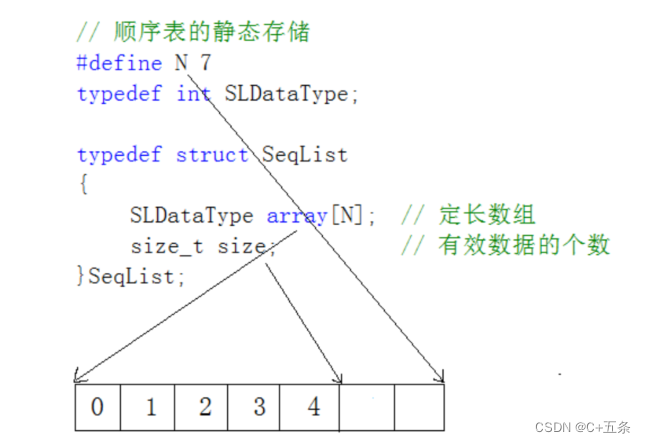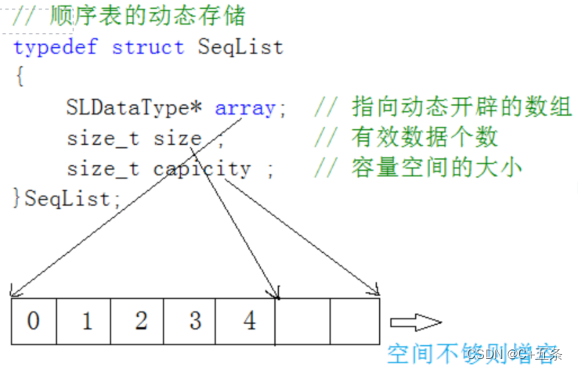数据结构:顺序表 模拟实现及详解
发布时间:2024年01月21日
目录
一、线性表
? 线性表(
linear list)是n个具有相同特性的数据元素的有限序列。 线性表是一种在实际中广泛使
用的数据结构,常见的线性表:顺序表、链表、栈、队列、字符串...
? 线性表在逻辑上是线性结构,也就说是连续的一条直线。但是在物理结构上并不一定是连续的,
线性表在物理上存储时,通常以数组和链式结构的形式存储。

二、顺序表
2.1顺序表的概念及结构
? 顺序表是用一段
物理地址连续的存储单元依次连续存储数据元素的线性结构,一般情况下采用
数组存
储。在数组上完成数据的增删查改。
顺序表一般分为
静态顺序表和
动态顺序表。
2.1.1静态顺序表
? 这里的静态一般是指顺序表的长度是定长,及数组的大小是固定的。

//静态顺序表
#define N 1000
typedef int SLDataType;
struct SeqList
{
SLDataType a[N];
int size;
};此处创建一个顺序表SeqList,其包含两个成员,定长数组array和记录array及顺序表中有效数据的个数size。
2.2.2动态顺序表

? 相比于静态顺序表,动态顺序表就显得更灵活和方便,静态顺序表只适用于确定知道需要存多少数据的场景。静态顺序表的定长数组导致N定大了,空 间开多了浪费,开少了不够用。所以现实中基本都是使用动态顺序表,根据需要动态的分配空间 大小,所以下面我们实现动态顺序表。
2.2动态顺序表接口实现
? 静态顺序表只适用于确定知道需要存多少数据的场景。静态顺序表的定长数组导致N定大了,空
间开多了浪费,开少了不够用。所以现实中基本都是使用动态顺序表,根据需要动态的分配空间
大小,所以下面我们实现动态顺序表的以下接口。
typedef int SLDataType;
// 顺序表的动态存储
typedef struct SeqList
{
?SLDataType* array; ?// 指向动态开辟的数组
?size_t size ; ? ? ? // 有效数据个数
?size_t capicity ; ? // 容量空间的大小
}SeqList;
// 基本增删查改接口
// 顺序表初始化
void SeqListInit(SeqList* psl);
// 检查空间,如果满了,进行增容
void CheckCapacity(SeqList* psl);
// 顺序表尾插
void SeqListPushBack(SeqList* psl, SLDataType x);
// 顺序表尾删
void SeqListPopBack(SeqList* psl);
// 顺序表头插
void SeqListPushFront(SeqList* psl, SLDataType x);
// 顺序表头删
void SeqListPopFront(SeqList* psl);
// 顺序表查找
int SeqListFind(SeqList* psl, SLDataType x);
// 顺序表在pos位置插入x
void SeqListInsert(SeqList* psl, size_t pos, SLDataType x);
// 顺序表删除pos位置的值
void SeqListErase(SeqList* psl, size_t pos);
// 顺序表销毁
void SeqListDestory(SeqList* psl);
// 顺序表打印
void SeqListPrint(SeqList* psl);void SLInit(SL* ps)
{
assert(ps);
ps->a = (SLDataType*)malloc(sizeof(SLDataType)*4);
if (ps->a == NULL)
{
perror("malloc failed");
exit(-1);
//return;
}
ps->size = 0;
ps->capacity = 4;
}
void SLDestroy(SL* ps)
{
assert(ps);
free(ps->a);
ps->a = NULL;
ps->capacity = ps->size = 0;
}
void SLPrint(SL* ps)
{
assert(ps);
for (int i = 0; i < ps->size; i++)
{
printf("%d ", ps->a[i]);
}
printf("\n");
}
void SLCheckCapacity(SL* ps)
{
assert(ps);
// 满了要扩容
if (ps->size == ps->capacity)
{
SLDataType* tmp = (SLDataType*)realloc(ps->a, ps->capacity * 2 * (sizeof(SLDataType)));
if (tmp == NULL)
{
perror("realloc failed");
exit(-1);
}
ps->a = tmp;
ps->capacity *= 2;
}
}
void SLPushBack(SL* ps, SLDataType x)
{
assert(ps);
/*SLCheckCapacity(ps);
ps->a[ps->size] = x;
ps->size++;*/
SLInsert(ps, ps->size, x);//更好的复用代码
}
void SLPopBack(SL* ps)
{
assert(ps);
// 温柔的检查
//if (ps->size == 0)
//return;
// 暴力的检查
//assert(ps->size > 0);
ps->a[ps->size - 1] = 0;
//ps->size--;
SLErase(ps, ps->size-1);
}
void SLPushFront(SL* ps, SLDataType x)
{
assert(ps);
//SLCheckCapacity(ps);
挪动数据
//int end = ps->size - 1;
//while (end >= 0)
//{
// ps->a[end + 1] = ps->a[end];
// --end;
//}
//ps->a[0] = x;
//ps->size++;
SLInsert(ps, 0, x);
}
void SLPopFront(SL* ps)
{
assert(ps);
/*assert(ps->size > 0);
int begin = 1;
while (begin < ps->size)
{
ps->a[begin - 1] = ps->a[begin];
++begin;
}
ps->size--;*/
SLErase(ps, 0);
}
int SLFind(SL* ps, SLDataType x)
{
assert(ps);
for (int i = 0; i < ps->size; i++)
{
if (ps->a[i] == x)
{
return i;
}
}
return -1;
}
// 在pos位置插入x
void SLInsert(SL* ps, int pos, SLDataType x)
{
assert(ps);
assert(pos >= 0 && pos <= ps->size);
SLCheckCapacity(ps);
int end = ps->size - 1;
while (end >= pos)
{
ps->a[end + 1] = ps->a[end];
--end;
}
ps->a[pos] = x;
ps->size++;
}
// 删除pos位置的值
void SLErase(SL* ps, int pos)
{
assert(ps);
assert(pos >= 0 && pos < ps->size);
int begin = pos + 1;
while (begin < ps->size)
{
ps->a[begin - 1] = ps->a[begin];
++begin;
}
ps->size--;
}
void SLModify(SL* ps, int pos, SLDataType x)
{
assert(ps);
assert(pos >= 0 && pos < ps->size);
ps->a[pos] = x;
}
文章来源:https://blog.csdn.net/2201_75880188/article/details/132762466
本文来自互联网用户投稿,该文观点仅代表作者本人,不代表本站立场。本站仅提供信息存储空间服务,不拥有所有权,不承担相关法律责任。 如若内容造成侵权/违法违规/事实不符,请联系我的编程经验分享网邮箱:chenni525@qq.com进行投诉反馈,一经查实,立即删除!
本文来自互联网用户投稿,该文观点仅代表作者本人,不代表本站立场。本站仅提供信息存储空间服务,不拥有所有权,不承担相关法律责任。 如若内容造成侵权/违法违规/事实不符,请联系我的编程经验分享网邮箱:chenni525@qq.com进行投诉反馈,一经查实,立即删除!
最新文章
- Python教程
- 深入理解 MySQL 中的 HAVING 关键字和聚合函数
- Qt之QChar编码(1)
- MyBatis入门基础篇
- 用Python脚本实现FFmpeg批量转换
- 第四篇 行为型设计模式 - 灵活定义对象间交互
- 【C++初阶】第二站:类与对象(上) -- 上部分
- [SWPUCTF 2021 新生赛]jicao
- 【JavaScript】面向对象之多态
- vue3新建项目,配置路由vue-router,引入element-plus
- element-plus里el-date-picker日期选择器,默认值不显示的问题
- FastAPI使用异步Redis
- Grind75第9天 | 733.图像渲染、542.01矩阵、1235.规划兼职工作
- 数据结构---双向链表
- 力扣 验证二叉搜索树 递归